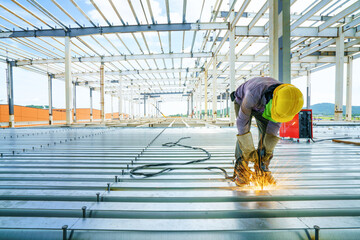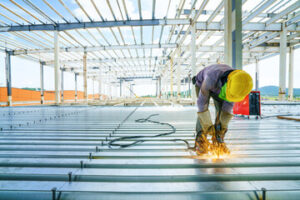A general contractor is a person who turns the renderings and blueprints of architects, engineers, and interior designers into real-life construction projects. They are in charge of the day-to-day operations and quality control on building sites.
They manage the project, handle the scheduling, and ensure that subcontractors are meeting their commitments. They must also have great problem-solving skills because problems will always arise on construction sites. Check out https://jrcsi.com/ to talk to a professional.
 Project Management
Project Management
The general contractor manages the day-to-day construction activities, while subcontractors like plumbers and carpenters complete the physical work onsite. A good GC is a master at scheduling, estimating costs, and coordinating the many details of a project such as getting building permits, managing temporary utilities on site, hiring and firing crew members, providing for the disposal or recycling of construction waste, monitoring schedules and cash flows, and maintaining accurate records.
A GC may employ their project managers, superintendents, foremen, and laborers to “self-perform” certain tasks, but generally subcontracts out 80-90% of the skilled trades. Most GCs have existing relationships with numerous specialty subcontractors so they can quickly put together teams for any given task at a moment’s notice.
While the responsibilities of a GC are broad and diverse, a GC’s true value is their ability to manage the entire project efficiently and cost-effectively. Often, this is why owners turn to a GC for large projects that are not part of their core business and for projects that require specialized expertise or equipment.
As a general rule of thumb, a GC charges a percentage of the total cost of the project. This can add up to quite a bit of money, so it’s important for anyone considering this approach to be aware of the costs involved.
The construction management (CM) process is a good alternative to a general contractor for those looking to save money on their project. The CM role is similar to that of a GC but differs in several key ways. The CM operates on the same “same side of the table” as the owner, which reduces friction and puts both parties in a better position to meet their project goals. This is why it’s not uncommon for a general contractor to offer CM services.
Scheduling
If you are planning a simple home remodel or building a house from the ground up, you’ll likely need the help of a general contractor. GCs have the experience and expertise to guide a construction project so that it stays within budget, on schedule, and meets city specs.
GCs coordinate the construction process with both clients and vendors. They create project schedules, which involve breaking the large construction project into manageable segments and assigning tasks to different teams. This process ensures that the requisite personnel are available when needed on-site. It also helps the team work cohesively and minimizes the risk of costly mistakes.
A GC will often employ their employees to perform certain tasks, but they’ll also use Subcontractors who specialize in carpentry, plumbing, electrical work, drywall, and painting. The GC will build project schedules and delegate specific tasks to each group of workers based on their skills and expertise. This process is very time-consuming and requires the GC to have very good multitasking skills.
As with any construction job, issues will arise on-site. A GC needs to be able to solve these problems quickly and efficiently so that the project remains on schedule. Whether it’s a worker getting hurt, a delivery that was delayed, or the need for an additional permit, the GC must be able to respond promptly and communicate effectively with all parties.
The GC is responsible for procuring all materials necessary for the construction of a building, including labor and equipment. They must reconcile each supplier’s bid against the overall project budget and obtain all required building permits. They will also be the primary point of contact between the architect and the construction team to ensure that construction happens as per the plans and designs specified in the blueprints and design documents.
Contract Negotiation
When contracts are negotiated, it’s important to remember the old saying “You get what you pay for.” Many projects are awarded to the lowest bidder. That often leads to a lot of change orders down the road that drive costs and cause project delays. A general contractor who is skilled at contract negotiation can minimize the number of change orders and ensure the project stays on budget.
Negotiation also helps to establish the scope of work for a project. A clear definition of the scope of work will prevent miscommunication and conflicts down the line. It’s essential to discuss any assumptions, plans, specifications, and conditions on which the scope of work is based during the negotiating process. This will help all parties understand their responsibilities and expectations.
Another point to consider is establishing who will be responsible for purchasing supplies and materials. This is important because it can impact the price of the supplies. Some contractors purchase the supplies themselves and include them in their cost estimates while others buy them from subcontractors or directly from suppliers. Negotiating with your contractor can help you get better prices on the supplies needed for the project.
In addition to negotiating the cost of supplies, it’s essential to negotiate warranty terms and schedules. It’s best to do this before a contractor starts working. This will ensure that the contract is fair to both parties and protects the interests of the general contractor. It’s also a good idea to include insurance clauses in the contract, especially when it involves risky work. This will prevent potential lawsuits down the line if something goes wrong. This is particularly true for large projects that take years to complete.
Purchasing Materials
One of the most important things that a general contractor does is to ensure that materials needed for construction are delivered as they’re needed. This means that they have to be in constant contact with wholesalers and supply stores to make sure the right deliveries are made at the correct times. Without these materials, work is essentially at a standstill and the project can’t move forward.
If the GC can’t find a good deal on materials and has to pay full retail, it can add up quickly. That’s why the best GCs are adept at finding the right deals and procuring materials in advance of the need to ensure that projects stay within budget. This requires a lot of careful analysis and planning, including performing quantity takeoffs on blueprints and creating detailed cost estimates that factor in things like material pricing, equipment rental costs, labor expenses, office space, insurance costs, and worker’s compensation.
Lastly, the GC is responsible for ensuring that all necessary inspections and permits are handled and that the project stays up to code. Failure to do so can lead to significant delays and could even cause the project to be shut down completely. The GC will work closely with the city and schedule necessary inspections throughout the building process to ensure that the work is being done correctly.
Whether it’s a small home improvement project or a large commercial development, the GC is responsible for managing the entire project from start to finish. This includes working with the architect to make sure that all specifications are met, negotiating payments with subcontractors and suppliers, and making sure that construction is taking place according to the plan.
Subcontractor Management
Subcontractor management is a process that lasts through the life of a construction project. It involves assigning tasks to subcontractors with clarity and ensuring they can understand what you want them to do. This can be challenging because subcontractors aren’t mind readers and need to be given precise instructions. They also need to be qualified to work on the job. This is why many general contractors use subcontractor management software solutions to help them manage the process.
Some types of subcontractors include the site preparation contractor who brings heavy equipment to a construction site and prepares the site for building. They may lay a driveway, remove trees, or excavate the foundation area for a new home. They may also build roads and parking lots on large projects. Framing and structural subcontractors build the walls, roofs, and other structures of a building from wood. These contractors also install windows, doors, and exterior sheathing. Electrical subcontractors work on wiring, lighting, and other electrical components for a project. They may also install generators and transfer switches.
Other subcontractors, such as concrete contractors, pour foundations and footings. They may also construct walls and other concrete structures. They may also install precast concrete materials for buildings, culverts, and other infrastructure projects.
General contractors typically use a cost-plus contract to award subcontracts to their preferred contractors. This type of contract allows the GC to define both labor and material costs in their bids so they can be compared with each other. This can be beneficial for both parties since the GC can be confident they did not make any errors in their estimations and the subcontractors can negotiate for lower prices on materials or labor.



